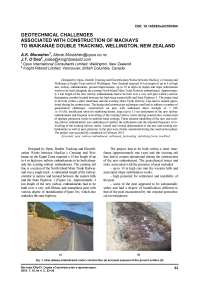Geotechnical challenges associated with construction of MacKays to Waikanae double tracking, Wellington, New Zealand
Автор: Murashev A.K., Odea J.T.
Рубрика: Теория расчета строительных конструкций
Статья в выпуске: 4 т.15, 2015 года.
Бесплатный доступ
Designed by Opus, Double Tracking and Electrification Works between MacKay’s Crossing and Waikanae at Kapiti Coast north of Wellington, New Zealand required 14 km length of up to 4 m high new railway embankments, ground improvement, up to 30 m high cut slopes and slope stabilisation works to be built alongside the existing North Island Main Trunk Railway embankment. Approximately 4 km length of the new railway embankments had to be built over a very soft peat within a narrow designation corridor located between the high steep eastern hills and State Highway 1. The project had to be built within a short timeframe and the existing Main Trunk Railway Line had to remain operational during the construction. The design and construction techniques used had to address a number of geotechnical challenges: construction on peat with undrained shear strength of 7 kPa to 15 kPa, insufficient room for stabilising berms, large (up to 1.5 m) settlements of the new railway embankments and frequent re-levelling of the existing railway tracks during construction, construction of upslope protection works to stabilise steep cuttings. Finite element modelling of the new and existing railway embankments was undertaken to predict the settlements and the required frequency of re-levelling of the existing railway tracks. Lateral and vertical deformations of the new and existing embankments as well as pore pressures in the peat were closely monitored during the construction phase. The project was successfully completed in February 2011.
Peat, railway embankment, settlement, preloading, stabilising berm, trackbed
Короткий адрес: https://sciup.org/147154436
IDR: 147154436 | УДК: 627.514 | DOI: 10.14529/build150404
Текст научной статьи Geotechnical challenges associated with construction of MacKays to Waikanae double tracking, Wellington, New Zealand
Designed by Opus, Double Tracking and Electrification Works between MacKay’s Crossing and Wai-kanae on the Kapiti Coast required a 14 km length of up to 4 m high new railway embankments to be built alongside the existing railway embankment. The existing rail line is a section of the North Island Main Trunk Railway and was a single track. A substantial length of the railway corridor is narrow and located between the eastern hills and the State Highway 1 (Figure 1a). Approximately 4 km length of the new railway embankments had to be built over a very soft fibrous and amorphous peat with various degree of humufication (Figure 1b), which also underlies the state highway.
The project had to be built within a short timeframe (approximately one year) and the existing rail line had to remain operational during the construction of the new embankment. The geotechnical issues and risks, associated with the presence of peat included:
-
– up to 30 m high cuts into the western hills and associated slope stabilisation works;
-
– high potential for settlement and instability of the peat;
-
– some of the peat appeared to be substantially softer and had a degree of humification different to that of the peat encountered by the original geotechnical investigations;
Fig. 1. New railway embankment under construction (a) and peat exposed at the ground surface (b)
-
– settlement of the existing railway embankment due to the load from the new embankment;
-
– reduction in peat strength due to reduced effective stresses in the peat supporting the embankments as a result of additional seepage pressures caused by artesian groundwater;
-
– potential for settlement and damage to the state highway pavements alongside the new railway embankment, due to ground surface settlement beyond the footprint of the new embankment;
-
– potential for settlement of the buildings located close to the new fill embankments;
-
– the need to keep the existing railway track operational (trains run every 10 minutes);
-
– inadequate support to overhead electric traction structure foundations founded in peat;
-
– where the railway corridor was narrow, retaining walls were required to support the new fill embankment, these were founded on peat and had to be designed to tolerate large settlement;
-
– short timeframe for the project;
-
– the need to construct new underground services (large diameter drainage pipes, cables etc) at the toe of the new embankment which would reduce the stabilising forces, could disturb the peat and destabilise the embankment;
-
– insufficient room for stabilising berms for some sections of the railway corridor.
Site conditions
The Kapiti Coast is a narrow triangular shaped coastal plain between the Tararua Range and the Tasman Sea. The coastal plain ranges from 1km wide near MacKay’s Crossing to 15 km wide near Wai-kanae. The project site has high seismicity. The seismic hazard is dominated by the presence of the Ohariu Fault which is a major active fault in the Wellington region located at 0.2 km to 2 km from the railway route. The Ohariu Fault has an estimated average earthquake rupture recurrence interval of approximately 1500–5000 years. A single event is likely to produce 3 m to 5 m of lateral slip and an associated 7.5 magnitude earthquake resulting in a design peak ground acceleration of 0.7g. The Ohariu Fault last ruptured approximately 1000 years ago near Paraparaumu.
The Tararua Range developed from the uplifting and tilting of basement rock along major lower North Island active faults. Bedrock is exposed along the eastern side of the railway corridor. It forms the steep hill slopes and is typically mantled by colluvium or rock talus. Bedrock generally consists of moderately to completely weathered, closely jointed greywacke sandstone with minor argillite (siltstone and mudstone). West of the Tararua Ranges there are sand dunes and peat that has developed from coastal progradation since approximately 9,000 years ago. Between MacKay’s Crossing and Paraparaumu, the rail corridor is located at the boundary between steep rocky hill slopes (historic sea cliffs) to the east and sits on flat depositional plains to the west. Between Paraparaumu and Waikanae the rail corridor lies on the western margin of the uplifted marine terrace and fluvial aggradations terrace. Recent sand dune and peat deposits lie to the west of these marine terrace deposits. In places, the marine terrace has become deeply incised and has filled with younger softer sediments.
Typical ground conditions for soft areas comprised a thin (0.3 m to 2 m thickness) capping layer of loose silty sand over 3 m to 8 m thick layer of very soft fibrous or amorphous peat underlain by medium dense silty sands. Groundwater level was between 0.2 m and 1 m below the ground surface level. Cone Penetration tests (CPTs) were used to identify boundaries of the peat areas and the peat layer thickness. Boreholes were drilled at the locations where peat layer thickness was the largest, the peat was softer than at other locations and where high new fill embankments were required. In-situ large shear vane tests were undertaken in the boreholes and indicated undrained shear strength varying from 7 kPa to 15 kPa. It is known that shear in peat occurs at some distance from the edge of the vanes due to the presence of fibres and, as a result, undrained shear strength assessed by conventional methods could be higher than the actual in-situ shear strength. Therefore reduction factors of 0.5 to 0.7 proposed by the Swedish Geotechnical Society were used to reduce the measured in-situ undrained shear strengths. Piston samplers were used to extract the peat samples from the boreholes. Consolidation, direct shear box and consolidated undrained triaxial tests with measurement of pore pressures were undertaken on the peat samples. However, laboratory test data may have been affected by sample damage due to the sampling, transportation and trimming. Therefore, the peat parameters were chosen based on the consideration of the field and laboratory test data, previous case studies for similar ground conditions in the area and were then refined based on the results of the construction monitoring. Typical physical, deformation and strength parameters of the fibrous peat are given in Tables 1 and 2. The modulus E of the peat is very low due to its soft nature and high void ratio.
Table 1
Physical properties of fibrous peat
|
Bulk unit weight, kN/m3 |
Dry unit weight, kN/m3 |
Unit weight of solids, kN/m3 |
Water content, % |
Void ratio |
Organic content, % |
|
10.02 |
1.3 |
15.9 |
676 |
11 |
95 |
Table 2
Typical deformation and strength parameters of fibrous peat
|
c', kPa |
φ', degrees |
c v , m2/year |
E, kPa |
ν |
|
0 |
40 |
2 |
150 |
0.15 |
Railway embankments
The new railway embankments had to be constructed alongside the existing railway embankments. For the 4 km length of the new railway embankments founded on the soft peat, large settlement of the new embankments and of the existing railway embankments (due to the influence of the new embankments) was expected. The existing North Island Main Trunk Railway located on the existing embankment had to remain operational during the construction phase of the project. The following construction techniques were considered for the new embankments:
-
– geogrid-reinforced floating fill embankment (with stabilising berms) constructed by a staged loading technique with preload fill to reduce postconstruction settlement;
-
– displacement of the soft peat layer by surcharging;
-
– partial or total excavation of soft layer to assist displacement of the peat;
-
– conventional or geotextile-encased stone columns in the peat to support the new embankment;
-
– deep mixing (using cement, lime, fly ash or gypsum or a combination of those);
-
– piling through the peat with geogrid-reinforced granular raft beneath the new embankment;
-
– lowering the profile of the whole railway alignment, so that the height of the fill embankment could be reduced and, as a result, reduce the load on the peat;
-
– constructing new embankments of lightweight fill or polystyrene blocks.
Based on the consideration of the costs and associated risks for each option, the floating embankment option was adopted. Design for the staged loading was developed based on the detailed analysis of the stressstrain state of the new and existing fill embankments and of the underlying soils and peat. Numerical modelling of the stress-strain state of the fill embankment based on complex non-linear peat and soil models was not possible within the project programme and budget constraints. The stress-strain soil behaviour was described by a simple elasto-plastic Mohr-Coloumb model. The soil model was used in the finite element (FE) analysis and produced a realistic estimate of settlement and lateral displacement distribution and was also used to assess the stability of the embankments. The conventional one-dimensional consolidation theory was used for initial analysis, but FE modelling was considered to be more appropriate because of large lateral deformation in the soft peat layer under the new embankments that could not be modelled by one-dimensional consolidation theory. The staged construction process was modelled in effective stresses applying new rows of finite elements at each loading stage.
The bulk unit weight of peat is low. The results of the stress-strain analysis are very sensitive to the magnitude of the bulk and submerged unit weight of the peat, as these define the initial in-situ stress state of the peat and its shear resistance. In our analysis, the unit weight of the peat was assumed to vary depending on the volume stress level which resulted in more realistic submerged unit weight of the peat in the modelling. It should also be noted that the already low effective stresses in the peat (due to its low unit weight) can be further reduced due to additional seepage pressures created by uphill water filtration (artesian groundwater), which was the case for one of the sections of the new embankment. The modelling enabled a decision on the size of the stabilising berms and to identify approximate possible maximum heights of the new fill embankment for given conditions. Distribution of the deviatoric strain for a typical embankment is indicating large shear deformation (lateral flow) in the peat (Fig. 2a) which is consistent with the observed behaviour.
а)
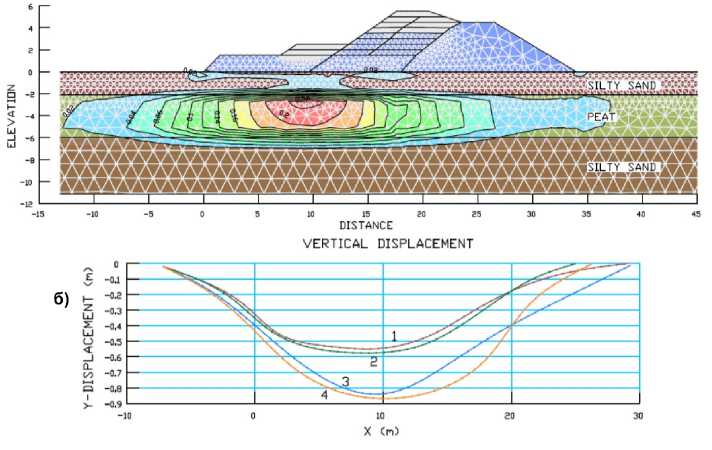
Fig. 2. (a) Distribution of deviatoric strain; (b) distribution of vertical displacement at elevation y=0 for loading Stages 1 (1 – FE analysis, 2 – field measurements) and 3 (3 – FE analysis, 4 – field measurements)
The modelling allowed a design to be developed for a typical new fill embankment (Fig. 3). Geogrid reinforcement was used to improve the stability of the new fill. Prefabricated vertical drains were installed through the peat layer to speed up the consolidation process. Inclinometers (INC), settlement plates (SP), settlement stations (SS) and vibrating wire piezometers (VW) were installed and a detailed monitoring programme was developed and implemented to make sure that the actual behaviour of the fill embankment was not substantially different from the predictions based on numerical modelling. The settlement from each load lift was required to reach 50 % to 90 % of primary consolidation settlement and then the next fill lift was constructed. The existing railway embankments also experienced settlement as they were located within the settlement bowl generated by the new fill. The predicted and measured vertical displacement (or settlement) for loading Stages 1 and 3 are shown on Fig. 2b. Frequent re-levelling of the ballast (tamping) was required to keep the existing railway track deformation within required tolerances and operational. The need for tamping was triggered by the settlement monitoring data which was received and interpreted on a weekly and sometimes daily basis. Settlement of the ex- isting railway embankments was also closely monitored during the construction of drainage pipes and deep pile foundations of traction structures in soft peat areas. To keep the existing tracks operational, very stringent requirements with respect to the deformation of the existing railway embankment and re-levelling (tamping) of the existing track were put in place. Large (up to 1.5 m) settlement of the new fill embankment and smaller (up to 200 mm) settlement of the existing railway embankments occurred, while the required tolerances for the new and the existing tracks required longitudinal deviation (differential settlement of the tracks) of less than 14 mm and twist of less than 10 mm over 10 m track length. Given the risk, a detailed settlement monitoring program for the existing railway embankments was developed and adhered to during construction.
For 4.5 m high new embankments located on soft peat, large initial fill lift height increments were initially used to speed up construction. However, our monitoring data indicated substantial lateral flow in the peat layer indicating a squeeze type failure of the peat beneath the new embankment with associated continuous sinking of the embankment into the soft ground (Fig. 4). Detailed monitoring of the lateral
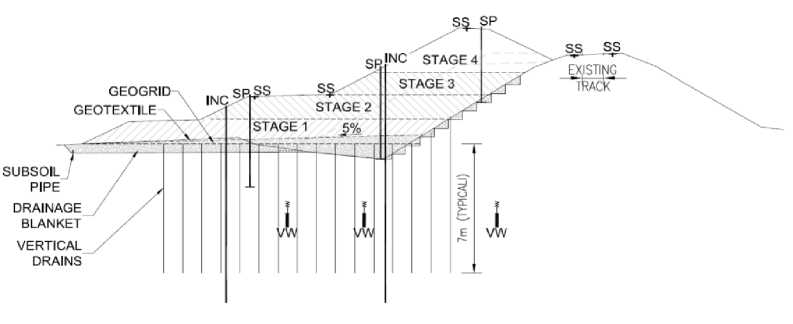
Fig. 3. Typical fill embankment design and instrumentation

Fig. 4. Horizontal displacement of peat beneath new fill embankment measured by inclinometers (solid line) and fill height (dashed line) as a function of time
deformation of the peat during each stage of loading using inclinometers and shear probes enabled the designers to carefully choose appropriate smaller fill lift height increments in order to minimise lateral deformation (flow) of the peat and to make sure that consolidation and strengthening of the peat was occurring during preloading (Fig. 4).
The stage-loading regime was refined during construction based on settlement monitoring data. It was critical for the project to construct the new embankments within the shortest possible timeframe and to minimise residual (secondary) settlement due to the creep of the peat. Therefore, prediction of the magnitude of total settlement and of the time required for the settlement to stabilise was important. The client (KiwiRail) wanted to speed up the construction. Therefore some embankments were only partially preloaded (i.e. reduced level of preload or reduced time of preloading were used) and then immediately put into operation with a level of residual creep settlement of up to 150 mm. Monitoring data collected during construction indicated that most of the new and existing fill embankments performed as predicted. Regular post-construction monitoring and re-levelling (tamping) of the new track within the areas with partial preloading was required to make sure that the track remained operational. The presence of the soft peat and silt beneath the railway embankments resulted in the risk of substantial trackbed deformation under the repeated train loads. Therefore, even in the areas with the new track at approximately ground surface level (i.e. where embankments were not required), up to 1.5 m thickness of the soft material was undercut and replaced with geogrid-reinforced granular rafts.
Cut slopes and retaining walls
Some sections of the railway corridor located between State Highway 1 and the eastern hills were too narrow to fit in the new fill embankment. Where it was possible, the corridor was widened by cutting into the eastern hills at stable slope angles (Fig. 5b). Where the original or proposed slopes had inadequate stability, slope stabilisation measures were developed and implemented. These measures included conventional retaining walls, soil/rock nails and 10 m high 1.2 m diameter reinforced concrete soldier pile walls tied back with prestressed multi-strand anchors (Fig. 5a). All walls were designed for high seismic loads in accordance with the New Zealand Building Code.
Where the railway corridor was too narrow to construct a stable embankment with unsupported fill batters or embankments with stabilising berms, the fill batters were constructed as geogrid reinforced slopes for slopes less than 50 degrees to the horizontal, or geogrid-reinforced soil (GRS) retaining walls for batter angles of 50 to 80 degrees. The steep angle of the GRS wall facing resulted in larger stress concentration in the peat below the retaining wall and partial excavation and replacement of the peat with geogrid-reinforced granular raft below the underside of the wall was required to overcome insufficient bearing capacity of the peat.
Also, the embankments containing retaining walls were expected to experience a settlement of up to 0.5 m. Therefore a hybrid Maccaferri Green Terramesh system with flexible steel wire facing and geogrid reinforcement was utilised. Figure 6 shows these walls during and immediately after their construction.
Conclusions
The presence of soft peat and silt required extensive geotechnical investigations and analysis for the 14 kilometres of KiwiRail Double Tracking and Electrification Works between MacKay’s Crossing and Waikanae at Kapiti Coast north of Wellington, New Zealand. For the range of typical railway embankment weight and train loads, the stress-strain state of these materials was within a substantially non-linear phase of their behaviour, resulting in large deformations, degradation of stiffness and accumulation of plastic strain under train loads and plastic flow under large static loads. Staged loading construction with preloading of the fill embankments, reinforced soil walls with flexible facing, and conventional replacement method
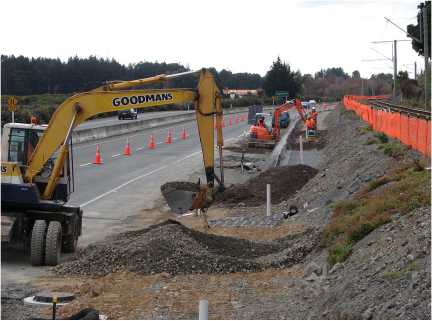
а)
Fig. 5. Terramesh Green walls during (a) and immediately after construction (b)
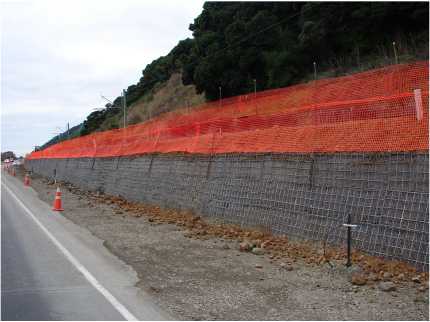
b)
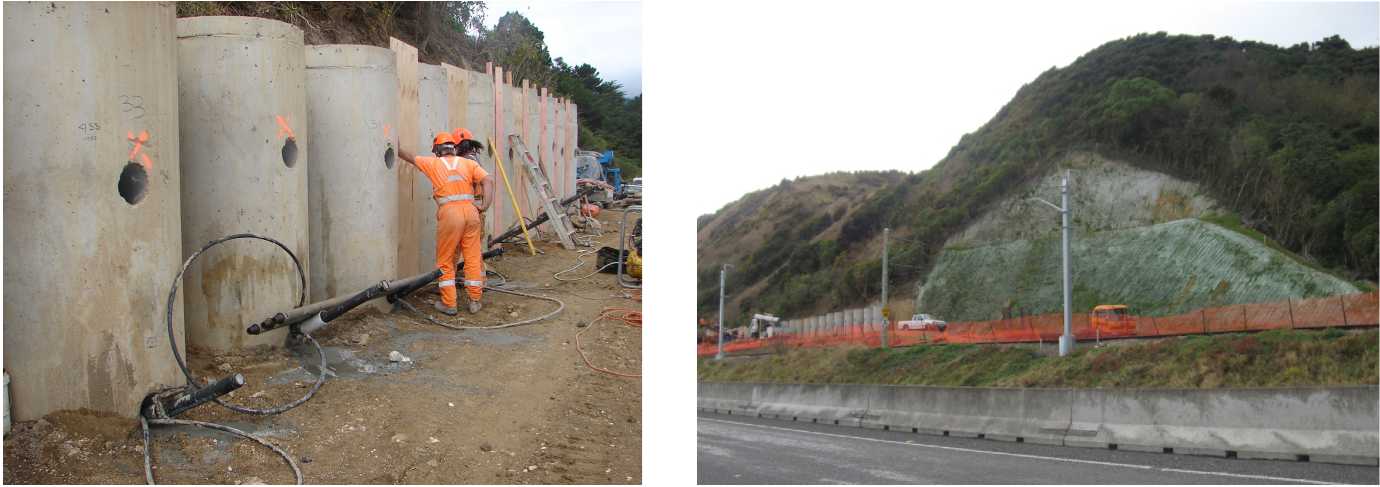
а)
b)
Fig. 5. Exposed upper part of a 10 m high soldier pile wall with rock anchors under construction (a), widening of the railway corridor by using soldier pile walls and cut slopes (b)
were used to construct the new fill embankments and proved to be successful and cost effective solutions.
The risks associated with the behaviour of the existing track, and with early completion of the new railway embankments were successfully mitigated by the detailed deformation and pore-pressure monitoring programme and by regular re-levelling of the existing track through the construction period.
Acknowledgements
The authors wish to thank KiwiRail for allowing the information contained within this paper to be published and KiwiRail’s project manager Nick Allen who was closely involved in the assessment and consideration of geotechnical risks and design solutions and also, based on his knowledge of operational issues, provided a valuable input into the geotechnical design.

